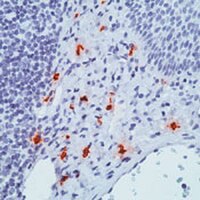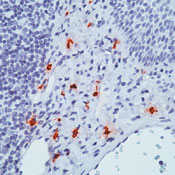444905 Sigma-AldrichAnti-Mast Cell Tryptase Mouse mAb (AA1)
This Anti-Mast Cell Tryptase Mouse mAb (AA1) is validated for use in Frozen Sections, Immunoblotting, Paraffin Sections for the detection of Mast Cell Tryptase.
More>> This Anti-Mast Cell Tryptase Mouse mAb (AA1) is validated for use in Frozen Sections, Immunoblotting, Paraffin Sections for the detection of Mast Cell Tryptase. Less<<Recommended Products
Overview
| Replacement Information |
|---|
Key Spec Table
| Species Reactivity | Host | Antibody Type |
|---|---|---|
| Ca, Fe, H, Mk | M | Monoclonal Antibody |
Products
| Catalogue Number | Packaging | Qty/Pack | |
|---|---|---|---|
| 444905-100UGCN | 塑膠安瓿;塑膠針藥瓶 | 100 μg |
| Product Information | |
|---|---|
| Form | Liquid |
| Formulation | In 10 mM PBS, pH 7.4. |
| Positive control | Cat, dog, human, or monkey mast cells |
| Preservative | None |
| Quality Level | MQ100 |
| Physicochemical Information |
|---|
| Dimensions |
|---|
| Materials Information |
|---|
| Toxicological Information |
|---|
| Safety Information according to GHS |
|---|
| Safety Information |
|---|
| Product Usage Statements |
|---|
| Packaging Information |
|---|
| Transport Information |
|---|
| Supplemental Information |
|---|
| Specifications |
|---|
| Global Trade Item Number | |
|---|---|
| Catalogue Number | GTIN |
| 444905-100UGCN | 04055977186208 |
Documentation
Anti-Mast Cell Tryptase Mouse mAb (AA1) MSDS
| Title |
|---|
Anti-Mast Cell Tryptase Mouse mAb (AA1) Certificates of Analysis
| Title | Lot Number |
|---|---|
| 444905 |
References
| Reference overview |
|---|
| Sommerhoff, C.P., et al. 2000. Biochim. Biophys. Acta.1477, 75. Little, S.S., and Johnson, D.A. 1995. Biochem. J. 307, 341. Morgan, S.J., et al. 1991. J. Allergy Clin. Immunol. 87, 111. Walls, A.F., et al. 1990. J. Pathol. 162, 119. Wall, A.F., et al. 1990. Clin. Exp. Allergy 20, 581. |

















